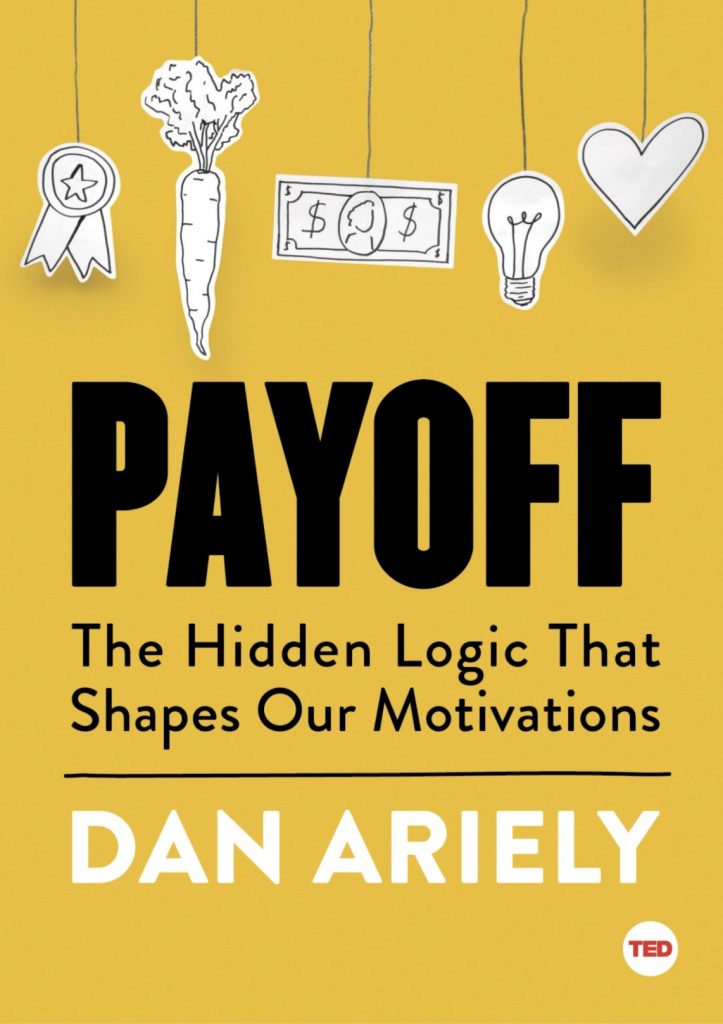Key Quote: “Knowing what drives us and others is an essential step toward enhancing the inherent joy – and minimizing the confusion – in our lives” (p. 16).
Key Concepts:
From Tragedy to Meaning and Motivation. The author explains that “we are [deeply] driven to tap into a sense of meaning, even when doing so is challenging and painful” (p. 14).
How to Destroy Motivation, or: Work as a Prison Movie. Finding meaning in work that lasts and that makes a difference can be a greater motivator than money or even love of the work itself.
The Joy of (Even Thinking That We Are) Making Something. When we are involved in the creation or customization of something, we imbue it with greater value.
Money Is From Mars, Pizza Is From Venus, and Compliments Are From Jupiter. Motivation tied to social considerations (praise, pizza) tends to have a more long-term positive affect on performance than monetary reward does. And performance is also profoundly affected by the demeanor of the collaborators in a group and the intrinsic joy one has in the task.
On Death, Relationships, and Meaning. An often undervalued or even ignored but very powerful motivation for human beings is the idea of leaving a legacy to the world.
The Answer to the Ultimate Question. Human motivation is a complicated and mysterious thing, and we are each driven by a variety of factors. We are wise to pay attention to and make the most of our own true motivations, so that we can find joy in life and excellence at work.
Experiments: How to Destroy Motivation
The “Sisyphic” Condition: A “Sisyphic” working condition is the opposite of a meaningful working condition. The name harkens back to the ancient Greek legend of Sisyphus, doomed in Hades to forever roll a boulder up a hill only for it to roll back down again. Sisyphic labor is useless and hopeless, by definition (p. 20). One key to making labor rewarding and to bringing out the best in ourselves and others is to make sure we understand the meaning of the work we are doing. We must see that our work is not in vain.
Lego Bionicles Experiment: Researchers asked participants in two different groups, labeled either “meaningful” or “Sisyphic,” to assemble Lego Bionicles. Researchers paid the participants in both groups for each Bionicle they put together. In the meaningful group, researchers took the completed Bionicles and set them aside elsewhere for later disassembly. In the Sisyphic group, researchers disassembled completed Bionicles right in front of the participants as soon as the Bionicle was built.
The results showed that on average, participants in the meaningful group built 11 Bionicles. On average, participants in the Sisyphic group built only 7 Bionicles (pp. 19-20). Seeing their work undone as soon as it was finished served as a profound damper to motivation.
There was another interesting finding: In the meaningful group, those individual participants who were already “naturally enthusiastic” about building Legos made even more than the standard 11 Bionicles. Natural joy in the work provided an even greater production boost.
However, in the Sisyphic group, researchers found “no relationship between the internal joy of making Bionicles and productivity” (p. 21). Seeing work undone immediately killed whatever boost the joy in the work would have provided. Even if we inherently enjoy our work, when we believe that the work is meaningless, we lose our motivation.
Prediction Experiment: Another interesting finding came out of the Lego Bionicles study. When researchers asked participants to predict the results of the Lego Bionicles experiment, people predicted that those working in the meaningful condition would only assemble one more Bionicle than those working in the Sisyphic condition. In other words, people did not think it would be very worthwhile for a Sisyphic company to invest very much in making work more meaningful (pp. 31- 32).
This experiment concluded that we underestimate just how effectively feelings of accomplishment can motivate people. Ariely believes that corporate leaders, without understanding this data, intuitively undervalue how much meaning matters in the workplace (p. 32).
Shredding Experiment: Researchers paid participants on a diminishing scale to find matching pairs on alphabet worksheets. The participants worked under three different conditions. In the “acknowledged” condition, participants wrote their names on their worksheets, and researchers examine the completed worksheets. In the “ignored” condition, participants did not write their names on their worksheets, and researchers did not examine the completed worksheets. In the “shredded” condition, participants did not write their names on the worksheets, and researchers shredded the completed worksheets without examining them (pp. 25-26).
The results showed that on average, acknowledged participants stopped working when the pay fell to 15 cents. Ignored participants stopped working at the 29-cent mark, and participants in the shredded condition stopped working at 27.5-cent mark (pp. 26-27). The study found that “when we are acknowledged for our work, we are willing to work harder for less pay, and when we are not acknowledged, we lose much of our motivation” (p. 27).
How to Reinforce Motivation
Invest in making work meaningful for employees in order to keep them motivated (p. 20). When people care deeply about their jobs, the quality of their work improves along with their morale and productivity (p. 76). For example, acknowledge the efforts of your coworkers and employees (p. 27). And respect their creativity and intelligence (p. 36). It is important to treat employees as individuals.
Leaders at Zappos encourage individuality and creativity among their employees by allowing them to decorate their cubicles in “weird” ways (p. 36).
At the personal level, we can motivate ourselves by changing our own mental framing of the work we are doing. For example, “we can ask ourselves: How is the work I’m doing helping someone down the road? What meaning can I find here?” (pp. 37-38).
Experiments: Finding Meaning in Creation
Origami Experiment: Participants, who were called “builders,” folded origami for an hourly wage. When their work was finished, researchers asked the builders to write down the maximum amount of money they would be willing to pay for their origami. Researchers also asked a control set of participants – who were called “buyers” and who did not make any origami – to write down the maximum amount of money they would be willing to pay for the origami.
In the study, the builders, who had made the origami themselves, were willing to pay five times more than the buyers. Builders also incorrectly believed that the buyers would be willing to pay the same (high) price for the origami (pp. 42-43). We have a particular attachment to our own creations. And we assume that everyone values our own personal creations as much as we do (pp. 42-43).
“Impossible” Origami Experiment: This time, researchers gave the builders useless origami folding instructions. Therefore, the builders had a harder time making the origami, and, consequently, the origami they made was poorly constructed.
In this case, the builders lost their objectivity and were willing to pay even more for the (less well-made) origami because they had worked so hard to create it! And the buyers were willing to pay even less for this origami because it was so poorly constructed (p. 43). It turns out “the more effort people expend, the more they seem to care about their creations” (p. 43).
Kids and Ideas Experiment: Researchers gave four-year-old participants a set of craft materials, asked them to imagine a picture they could create using the materials, and then asked them to tell the researchers exactly how to put the craft materials together to create that picture. Then, the researchers and the children switched roles, and the researchers told the children how to arrange the craft materials into a picture.
When researchers asked the children which picture the children preferred – the picture that came from their own imaginations, or the picture that they helped physically create – most of the children chose the picture that came from their own imaginations. “What all of this means is that, by a very young age, we already care about our ideas and are attached to them” (p. 50).
Customization, Creativity, and Identity
Just as the work we create is meaningful to us, so are the products we consume – particularly when we customize those products. Customization is not merely about preferences. It is about identity. Consumers are now creators (pp. 46-47).
“We become more invested as we pour effort into different activities, and with it experience greater love for we have created – our creations become part of ourselves and our identities.” Additionally, “we just don’t seem to recognize that the love for the outcome of our own efforts is limited to us alone” (p. 53). Creating something valuable by investing ourselves in a task or project is difficult work. Difficult work is often meaningful work (p. 54).
Experiments: Rewards and Relationships
Incentives Experiment: If factory workers reached their production target at the end of their shift, researchers rewarded them with one of three incentives: a $30 bonus, an encouraging text message from their boss, or a voucher for a pizza. Researchers only gave these incentives on the first day of the workweek. There was also a control group that received no incentive at all (pp. 61-62).
Each of the incentivized groups were more productive than the control group on the first day, but they were not more productive than the control group by the end of the week. Overall, the $30-bonus group was 6.5% less productive than the control group. The encouraging text message group remained the most engaged (pp. 65-66).
Monetary incentives have the potential to make people less motivated. It is important for leaders to measure the delayed effects of different incentives (pp. 67-68) and consider the enduring benefits of incentives that make the most of the social framework we live in.
Morale Experiment: Think you have no power or influence in a social group or at work? Participants role-played as members of a salary committee and tried to fairly distribute raises for employees at a theoretical company. The participants did not know that an actor had joined their committee. In different groups, the actor embodied one of four moods: “cheerful enthusiasm,” “serene warmth,” “hostile irritability,” or “depressed sluggishness.”
The groups in which the actor performed cheerful enthusiasm or serene warmth got along better, performed their main task more effectively, and distributed raises more fairly than the groups in which the actor performed negative emotions. However, the participants did not identify group dynamics as an important factor in their work performance (pp. 72-73). Although we underestimate their value, positive social forces improve the quality of our work and the work of others (p. 73).
Commitment, Goodwill, and Contracts
People are more motivated to invest in long-term commitments than in short-term ones (p. 74). In exchange for motivated work, businesses can practice their commitment to employees by investing in their professional development, personal growth, and well-being (p. 75).
Trust and goodwill motivate us to “step out of our standard job requirements in order to excel and innovate” (p. 82). Leaders can demonstrate goodwill through encouraging words, sincerity, and acts of appreciation (p. 87).
Trust is fragile, and business leaders should know that the legalese of certain contracts can diminish goodwill. Sometimes, the value of a hyper-detailed contract is not worth diminishing a professional relationship that has been built on goodwill (pp. 83-84).
Symbolic Immortality
It is also evident that “many of our motivations are based on a horizon longer than our lifetimes” (p. 91). We are motivated – either consciously or unconsciously – by the desire to leave behind a legacy (p. 97). “Arguably, the most powerful motivator in the world is our connection to others” (p. 101).

“Knowing what drives us and others is an essential step toward enhancing the inherent joy and minimizing the confusion in our lives” (p. 16).
Ariely, D. (2016). Payoff: The Hidden Logic That Shapes Our Motivations. New York: Simon & Schuster, Inc.
